Introduction
Dynamic Pricing is a feature designed to help properties optimize revenue by automatically adjusting room rates based on occupancy levels and timing. Unlike static pricing, which remains constant at all times, dynamic pricing allows the system to increase or decrease rates according to market conditions and occupancy targets.
To use this feature, users must first activate (subscribe to) dynamic pricing. When the Dynamic Pricing feature has not been activated, the page will only display the message: Please Subscribe To This Feature.
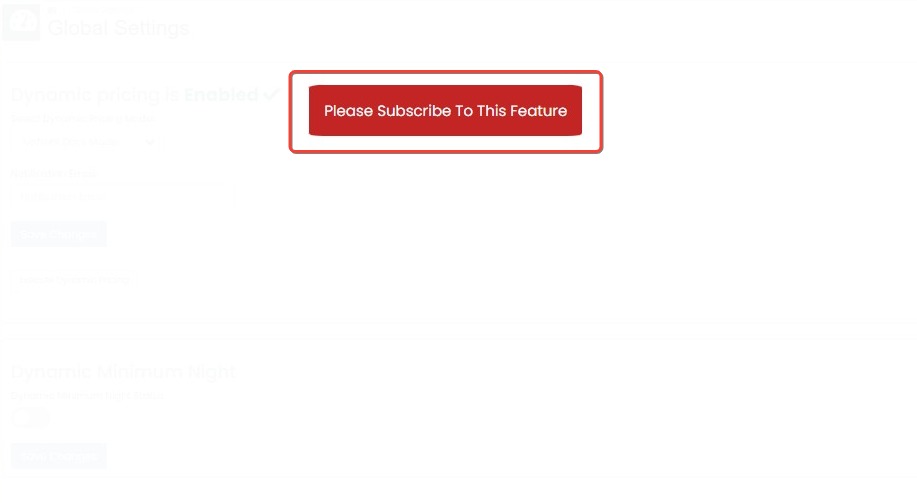
Global Settings
Global Settings is the main configuration center for Dynamic Pricing. Here, users can choose the desired dynamic pricing model, set the notification email destination, and fully enable and execute the feature.
How to Configure Global Settings
- Select Dynamic Pricing Model
From the Select Dynamic Pricing Model dropdown, the following options are available:- Upfront Days Model
- Custom Periods Model
- Dynamic Time
- Disable Dyn Pricing (if you want to completely disable dynamic pricing)
The selected model will determine the pricing strategy method applied by the system.
- Enter Notification Email
Enter an email address to receive notifications related to price changes.- If left blank, the system will default to using the property's primary email.

- If left blank, the system will default to using the property's primary email.
- Save Settings
Click the Save Changes button to save all settings.

- Manual Execution
Click the Execute Dynamic Pricing button if you wish to run the dynamic pricing process immediately instead of waiting for the scheduled automation.- After clicking, the system will display a confirmation: “System will execute dynamic pricing one time every hour. Are you sure you want to execute now?”
- Click OK to execute dynamic pricing immediately.
- Click Cancel to cancel the process.

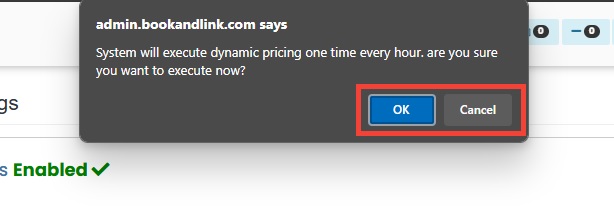
[!NOTE]
Troubleshooting Global Settings
Cannot select a Dynamic Pricing Model
- Make sure you have the necessary user permissions to configure Global Settings.
- Try refreshing the page or clearing your browser cache if the dropdown is unresponsive.
- Check for any active internet issues that might prevent the list from loading properly.
Notification email is not receiving alerts
- Confirm that the email address entered is valid and active.
- If the field is left blank, make sure the primary property email is correct and not blocked.
- Check your spam or junk folder for missed messages.
Save Changes button is not responding
- Ensure all required fields (such as pricing model) are filled in.
- Wait a few seconds after clicking to allow the system to process the update.
- Try saving again in a new browser tab or incognito mode to avoid cache issues.
Execute Dynamic Pricing button does not work
- Make sure you have selected a pricing model before attempting to execute.
- Confirm you have admin access to trigger manual execution.
- If the system does not respond after clicking "OK", reload the page and try again.
Changes in Global Settings do not affect pricing
- Double-check if the correct model is selected and saved.
- Dynamic pricing will only run automatically every hour—if you want changes to apply immediately, click Execute Dynamic Pricing.
- If problems persist, contact the support team to check for background execution issues.
Upfront Days Model
Upfront Days allows room rates to be adjusted based on occupancy levels and the number of days before the check-in date (upfront days). This feature is useful for encouraging early bookings when occupancy is low by offering discounts, and increasing prices as occupancy rises and the check-in date approaches.
How to Configure Upfront Days Model
- Select the Upfront Days model from Global Settings and click Save Changes.
- Go to the Upfront Days menu in the Dynamic Pricing navigation panel.
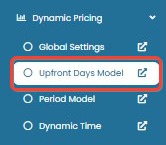
- The page will immediately display the price rule settings form.
- Fill in the following information:
- Occupancy Start (%) – End (%):
Define the occupancy range for this rule.
Example:0 – 20means the price will adjust when occupancy is below 20%. - Price Adjustment (%):
Enter the percentage for price adjustment. Use a negative value for discounts.
Example:-20%means the price will be reduced by 20%. - Maximum Upfront Days:
Specify how many days before check-in this rule applies.
Example:2means the rule is only active if the booking is made within 2 days before the check-in date. - Room Type:
Select the room to which this rule will apply.
The adjustment will automatically be applied to all rate plans for the selected room.
- Occupancy Start (%) – End (%):
- After completing the settings, click Update to apply the upfront days model.
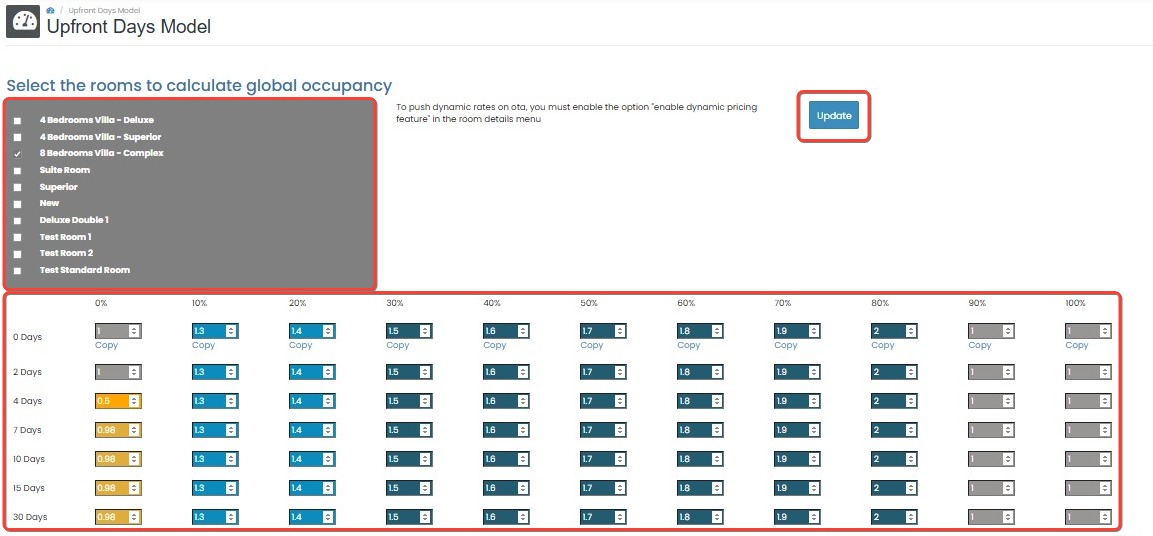
[!NOTE]
Troubleshooting Upfront Days Model
Cannot find Upfront Days menu
- Make sure you have selected the Upfront Days model in the Global Settings and saved the changes.
- Refresh the page or re-login to your account if the menu does not appear immediately.
Update button is not working
- Ensure all required fields (Occupancy %, Price Adjustment, Upfront Days, and Room Type) are filled in correctly.
- Avoid using non-numeric characters in numeric fields.
- Try again after refreshing the page or using a different browser.
Price adjustment is not reflected in room rates
- Confirm that the occupancy range and upfront day values match your current booking conditions.
- Note that this feature only affects pricing when the booking meets both occupancy and upfront day criteria.
- Check if another rule or pricing model is overriding this setting.
Room Type dropdown is empty
- Verify that room types have been properly created and activated in the system.
- If no rooms are listed, check your user permissions or contact the admin for access.
Price adjustment percentage is ignored
- Make sure the adjustment value is entered correctly (e.g., use
-10for a 10% discount,15for a 15% increase).- Do not include the
%symbol in the input; just use the number.
Period Model
Period Model allows users to set dynamic pricing based on room groups, occupancy ranges, and customized pricing rules. This model is ideal when you want to apply different pricing strategies to specific room types or groups within a certain time period. The Period Model is divided into three main configuration steps:
Group Setup (Occupancy Group)
Before setting dynamic pricing, you need to create an Occupancy Group to group room types that will have the same occupancy rules and pricing settings.
How to Configure Group Setup
- Click the Occupancy Groups tab.
- Click the Create Occupancy Group button.
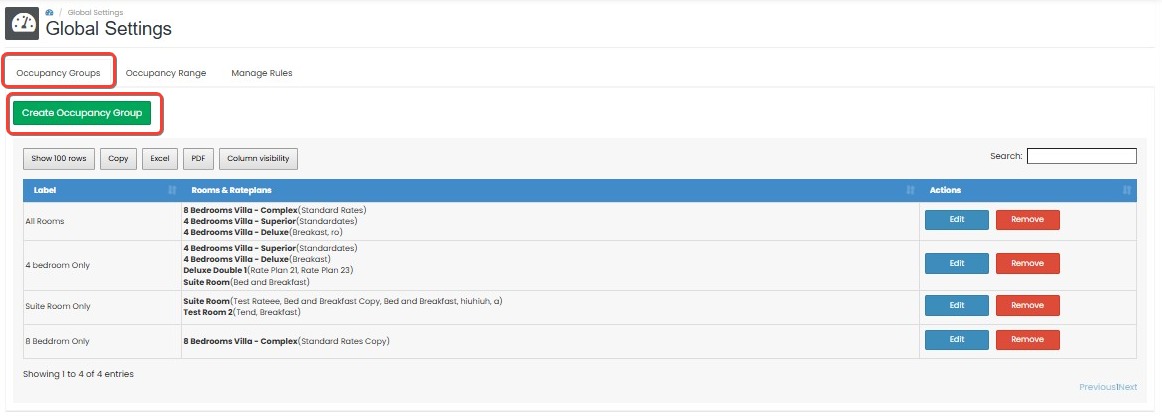
- Enter the following information:
- Label Name: The name of the group (e.g., "One Bedroom", "Deluxe Room").
- Room Type: Select one or more rooms to include in this group.
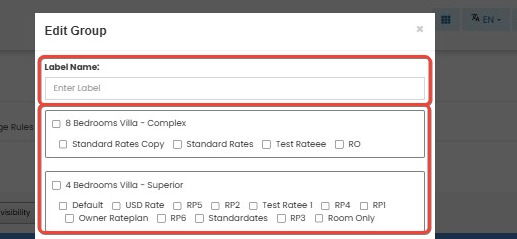
- Click Save Changes to save the group setup.
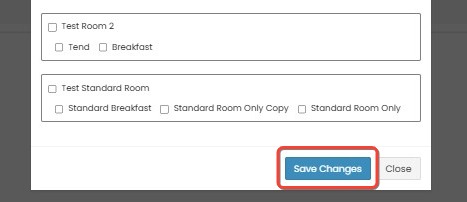
Occupancy Range
After the group is created, define the occupancy range that will serve as the basis for price adjustment.
How to Configure Occupancy Range
- Click the Occupancy Range tab.
- Click the Create Occupancy Range button.
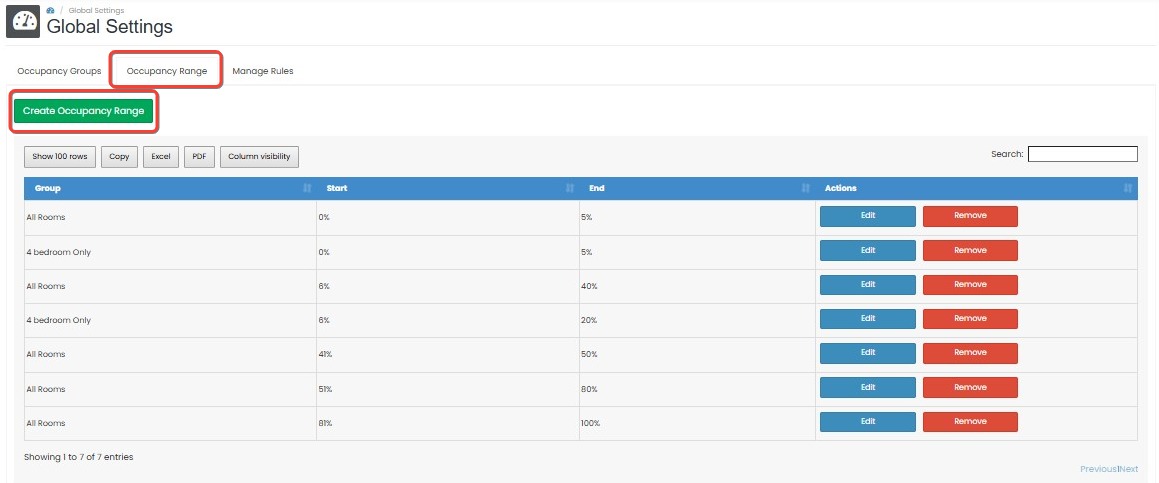
- Fill in the following information:
- Occupancy Group: Select the group you have previously created.
- Occupancy Start (%) and Occupancy End (%): Define the start and end percentage of occupancy for this rule.
Example: For the "One Bedroom" group, you can create rules like 0%–30%, 31%–60%, and so on.
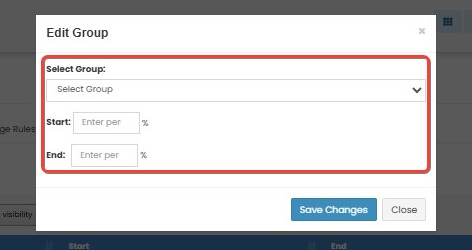
- Click Save Changes to save the occupancy range.
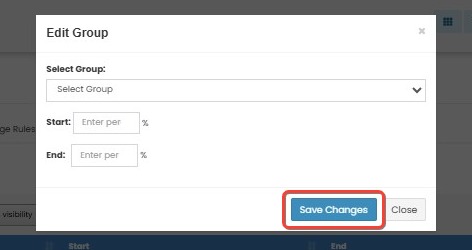
Room Pricing Rules (Manage Rules)
Once the Occupancy Range is set, the next step is to define pricing rules for each combination of occupancy and room type.
How to Configure Manage Rules
- Click the Manage Rules tab.
- Click the Add New Dynamic Pricing Rule button.

- Complete the following form:
- Label Name: The name of the group.
- Select Group: Select the group to which the rule will apply.
- Occupancy Rules: Choose the rule you want to apply for the selected occupancy group.
- Include / Exclude Date: Select specific dates to be included or excluded.
- Last Minute Restriction: Set a time for last-minute bookings (yes/no).
- Calculation Method: Choose the price calculation method (e.g., based on occupancy or availability).
- Days of the Week: Choose the days of the week when the rule will apply.
- Click Save Changes to save the rule.
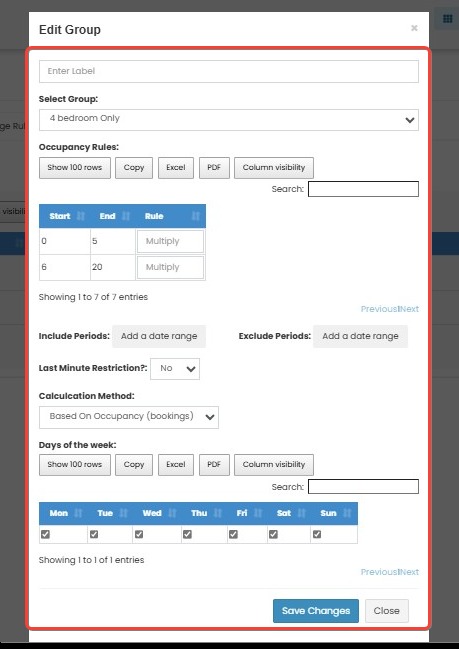
[!info] Note:
- You must complete the setup in the order of Group → Range → Rules for dynamic pricing to function correctly.
- Each time a setting is saved, the system will automatically update prices based on the latest rules.
[!NOTE]
Troubleshooting Period Model
Occupancy Group cannot be created
- Make sure the Label Name field is filled in correctly and at least one Room Type is selected.
- Avoid using special characters in the group name.
Rooms are missing from Room Type selection
- Check if the rooms have been properly configured and activated in the main system.
- Ensure your user role has permission to access all available room types.
Occupancy Range is not saving
- Confirm that both Occupancy Start (%) and Occupancy End (%) values are entered and within the range of 0–100.
- Make sure the selected occupancy group already exists and is saved correctly.
Manage Rules section does not display any groups or occupancy rules
- Ensure that Occupancy Groups and Occupancy Ranges have been configured first.
- The Manage Rules tab depends on data from the two previous steps and will remain empty if they’re missing.
Dynamic Pricing Rule not applied to rates
- Check if the Days of the Week, Date Range, or Occupancy Rules are too restrictive.
- Confirm the correct Calculation Method was chosen and that it aligns with your pricing strategy.
- Wait a few moments or refresh the page, as the system may need time to update the new rule.
Included/Excluded Dates not working
- Double-check the format and range of the selected dates.
- Conflicts between Include and Exclude dates may prevent the rule from being applied.
Dynamic Time
Dynamic Time allows you to adjust room rates based on specific hours within a day. This feature is particularly useful for properties such as daily hotels or properties that want to set special pricing during peak hours, such as evenings or weekends.
Unlike other models, Dynamic Time evaluates and applies price adjustments based on time within a day, not just on dates or occupancy.
How to Configure Dynamic Time
- Click the Dynamic Time Tab.
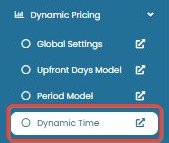
- Click "Dynamic Time Rule"

- Fill in the Dynamic Time Rule Details
- Label Name: Enter the rule name (e.g., "Evening Boost").
- Rules Multiplier: Define the multiplier for the selected rule.
- Start Time and End Time: Specify the start and end times (e.g.,
18:00 – 23:59). - Room Type: Select the room type that will be subject to this rule.
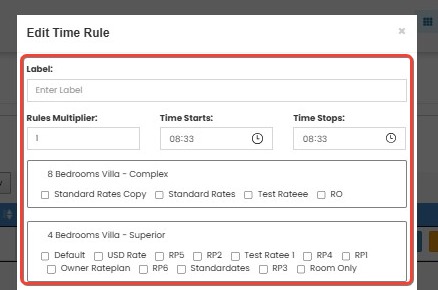
- Include / Exclude Date: Select specific dates to be included or excluded.
- Last Minute Restriction (Days): Set a time for last-minute bookings (yes/no).
- Days of the Week: Choose the days of the week when the rule will apply.
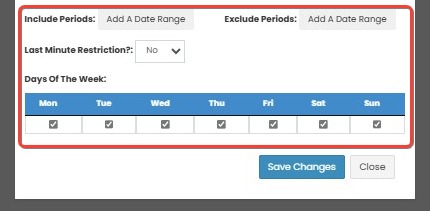
- Click "Save Changes" to save the rule.
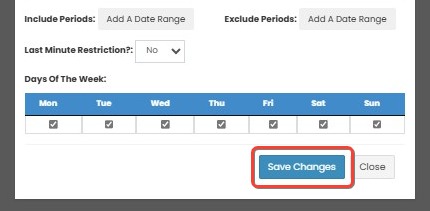
[!NOTE]
Troubleshooting Dynamic Time
Dynamic Time rule is not saving
- Ensure all required fields are filled: Label Name, Start Time – End Time, Rules Multiplier, and Room Type.
- Avoid using unsupported characters in the Label Name.
- Check for overlapping rules with identical time ranges and room types.
Price adjustment is not reflected during the specified time
- Confirm that the current time falls within the defined Start Time – End Time.
- Make sure the rule is set to apply on the current Day of the Week.
- Check if the current date is mistakenly excluded via the Exclude Date option.
Room type not appearing in the dropdown
- Ensure the room type has been properly configured and activated in the system.
- Verify your user account has permission to manage pricing for the selected room type.
Multiplier has no impact on rate
- Double-check that the Rules Multiplier is not set to
1(which means no change).- Make sure no other pricing rules or overrides are taking precedence during the same time slot.
Last Minute Restriction is not working as expected
- Confirm that the restriction is enabled and the number of days is defined correctly.
- Check if your booking attempt falls outside the configured last-minute window.